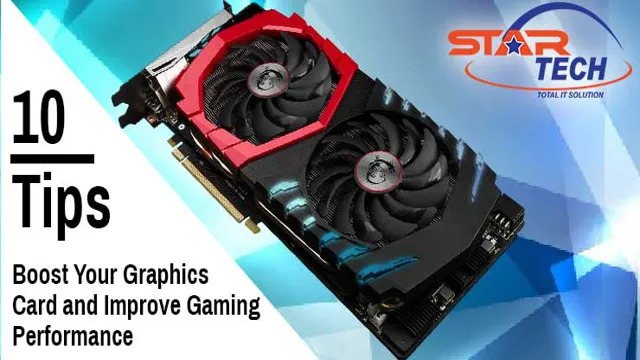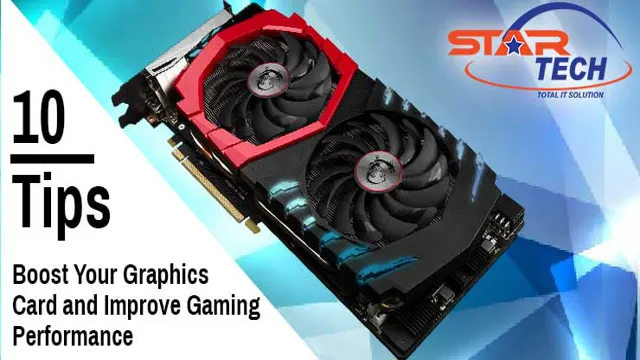Avid gamers and professionals who rely on their computers for graphic-intensive tasks constantly seek ways to maximize their graphics card’s performance. With the growing demand for better and higher quality graphics, it’s crucial to have a graphics card that can keep up with the demand. However, simply buying an expensive graphics card won’t solve the issue.
In fact, there are various tips and tricks that you can follow to boost your graphics card’s performance without having to spend a fortune. Whether you’re a gamer or work in a creative field, this post will provide you with some practical tips on how to optimize your graphics card’s performance. From updating drivers to overclocking, there are several ways to get the most out of your GPU.
In this article, we will deep-dive into some of the best techniques to enhance your graphics card’s capabilities. So, whether you’re looking for ways to get better framerates in games or want to speed up your workflow in graphic design software, read on to discover some useful tips and tricks.
Upgrade Your Graphics Card
Are you looking to boost your graphics card performance? Consider upgrading your graphics card for an impressive increase in speed and quality. A new graphics card can heavily improve your gaming, 3D rendering, or video editing experience. With newer models being released regularly, you can easily find an affordable option that suits your needs.
Simply ensure that the new graphics card is compatible with your computer’s system and has enough power to handle the workload you require. So, upgrade your graphics card and watch as your computer quickly and smoothly handles even the most demanding tasks. Trust me, it will be worth it!
Invest in a High-End Graphics Card
If you’re looking to enhance your gaming experience or improve your video editing, investing in a high-end graphics card is a step in the right direction. When it comes to computer hardware, the graphics card or GPU is what handles the processing of images and videos. A better graphics card means that your computer can handle more complex graphics, higher resolution, and faster rendering times.
Upgrading your graphics card can also have a significant impact on your gaming performance. With better FPS and smoother gameplay, you’ll be able to enjoy your games to the fullest. It’s important to note that not all graphics cards are created equal, so it’s essential to choose one that meets your specific needs.
Take into account factors such as power consumption, size, and compatibility before making your final decision. By upgrading your graphics card, you’ll be taking a step towards a more powerful computer that can handle all your gaming and video-editing needs with ease.

Consider Using an External GPU
Upgrading your graphics card can do wonders for your PC’s performance, especially if you’re looking to improve your gaming experience. But what happens when your PC doesn’t have an available slot for a new graphics card, or the processor isn’t compatible with the latest cards? This is where an external GPU comes in. By connecting an external GPU through a Thunderbolt port, you can give your laptop or PC a significant boost in graphics power.
It’s basically like adding a high-end graphics card to your system without having to open up your PC and fiddle with the insides. Not only does this upgrade option provide excellent flexibility, but it also allows for easier upgrades down the line, as you can swap out the external GPU for a new model without having to worry about compatibility issues. So, if you’re looking for a way to upgrade your graphics without having to invest in a new PC, consider using an external GPU.
Optimize Graphics Settings
Are you looking to boost your graphics card performance? One effective method is to optimize your graphics settings. By adjusting the settings, you can increase your frame rates and improve the overall quality of your visuals. Start by lowering your graphics quality to a level that you find acceptable.
This will free up resources, giving your graphics card more capacity to handle demanding tasks. You can also turn off any unnecessary graphical effects like motion blur and ambient occlusion, which may affect performance. Another way to boost your graphics card performance is to update your drivers.
This ensures that your graphics card is running at peak efficiency and utilizes the latest available features. By optimizing your graphics settings and keeping your drivers up to date, you can make the most of your graphics card and take your gaming experience to the next level.
Lower Graphics Settings in Games
Lowering graphics settings in games can greatly improve the performance of your system and enhance your gameplay experience. The graphics settings in a game determine the quality of the images, textures, and overall visual effects of the game, as well as the workload on your computer’s graphics card. By lowering these settings, you can reduce the amount of processing power required by your system, allowing the game to run more smoothly and efficiently.
This can result in less lag, fewer stuttering issues, and an overall more enjoyable gameplay experience. It’s important to note, however, that lowering graphics settings may affect the quality of the game’s visuals, so it’s recommended to find a balance that suits both your system’s capabilities and your personal preferences. So, if you’re experiencing performance issues while gaming, consider optimizing your graphics settings to maximize your gaming experience.
Update Graphics Drivers
If you’re a gamer or use your computer for graphic-intensive work, having updated graphics drivers is key to optimizing your experience. Outdated drivers can cause performance issues, crashes, and even hardware damage. To avoid these issues, make sure to regularly update your graphics drivers.
This not only ensures that your graphics card is correctly communicating with your computer but can also provide access to new features and performance improvements. You can update your drivers manually or with software tools, such as Nvidia GeForce Experience or AMD Radeon Software. Don’t let outdated graphics drivers hold you back from the best possible experience.
Keep them up to date and unlock the full potential of your computer’s graphics capabilities.
Use GPU Overclocking Tools
GPU overclocking tools are crucial for optimizing your graphics settings and enhancing your overall gaming experience. These tools allow you to tweak clock speeds, adjust voltage, and fine-tune fan settings to push your GPU to its limits. With careful monitoring, you can optimize your GPU’s performance without the risk of damaging it.
For instance, MSI Afterburner is a popular and user-friendly tool that allows you to adjust core voltage, power limit, and fan speed. By using such tools, you can unlock your GPU’s full potential and boost your gaming performance. Remember to use caution when overclocking and monitor your temperatures regularly to avoid overheating and system instability.
By using GPU overclocking tools, you can enjoy the best possible graphical fidelity and smooth gameplay.
Keep Your Graphics Card Cool
If you’re a gamer or someone who uses graphic-intensive applications like video editing software, then you know how important it is to keep your graphics card cool. Overheating can not only reduce your graphics card performance, but also damage it over time. The first step to boost your graphics card performance is to ensure that it’s not running too hot.
One easy way to cool down your graphics card is by installing additional cooling hardware such as a fan, heatsink or liquid cooling system. You can also adjust the fan speed settings to higher levels which will keep the temperature low while you’re gaming or running graphics intensive software. Conducting regular maintenance checks and cleaning your graphics card from dust and debris buildup can also improve its performance.
In conclusion, keeping your graphics card cool is a simple yet effective way to boost its performance and prolong its lifespan.
Clean Your Graphics Card
Graphics card Keeping your graphics card cool is a major priority if you are a serious gamer or graphic designer. Overheating can cause your graphics card to malfunction, leading to significant damage and costly repairs. One simple way to prevent overheating is by regularly cleaning your graphics card.
Dust and debris can accumulate in the fan, causing it to work harder and generate more heat. By removing the accumulated dust from the fan and heat sink, you can significantly improve the cooling performance of your graphics card. You can do this by using compressed air or a soft brush to gently clean the components.
Remember to be careful not to damage any of the small components, always ground yourself to prevent static electricity buildup, and switch off your power supply before cleaning your graphics card. By keeping your graphics card clean, you can prolong its life and enjoy maximum performance for longer periods.
Improve Airflow in Your PC Case
One of the most critical components of your PC’s cooling system is your graphics card. Graphics cards are notorious for heating up quickly, and if not adequately cooled, they can quickly damage your entire system. That being said, improving your PC case’s airflow is essential, especially if you’re a hardcore gamer.
So, how can you keep your graphics card cool? Firstly, consider investing in a graphics card with good cooling capabilities. This will help you maintain a lower temperature even when your system is running hot. However, improving your case’s airflow is also crucial.
Try adding more fans to your case or replacing your current fans with higher-performing ones. Additionally, ensure that your graphics card isn’t squeezed tightly between other components and has enough space for air to circulate. Keeping your graphics card cool ultimately impacts your PC’s overall performance and longevity.
Don’t let overheating cause your system to malfunction; take the necessary steps to improve your PC’s cooling capabilities.
Conclusion
When it comes to boosting graphics card performance, it’s all about finding the sweet spot between pushing the limits and maintaining stability. With the right combination of overclocking, optimization, and maintenance, you can unleash your GPU’s true potential and take your gaming and multimedia experiences to the next level. So go ahead, give your graphics card the boost it deserves and watch as your pixels come to life in glorious detail.
“
FAQs
How can I boost my graphics card performance for better gaming experience?
You can boost your graphics card performance by updating your driver software, overclocking your GPU, adjusting visual settings, and optimizing your system for better performance.
Is it safe to overclock my graphics card to improve its performance?
Overclocking can improve graphics card performance, but it can also cause overheating, instability, and damage to your hardware if not done properly. Make sure to follow safety precautions and use reliable software to avoid any issues.
Can upgrading my graphics card improve overall system performance?
Yes, upgrading your graphics card can improve overall system performance, especially if you have an outdated or low-end GPU. A better graphics card can handle more demanding tasks and improve your system’s capability in terms of video rendering, gaming, and other graphic-intensive applications.
What are some tips to optimize my graphics card settings for better performance?
Some tips to optimize your graphics card settings include adjusting the resolution and refresh rate, enabling hardware acceleration, disabling unnecessary visual effects, and enabling vertical sync. You can also use system tuning software for further customization and performance boosting.


